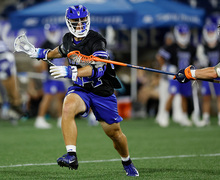Up and up: SU professor gains fame, critical acclaim with success of new book, ‘Tenth of December’
Photo Courtesy of Chloe Aftel
George Saunders, author of the book "Tenth of December," professor at Syracuse University
Kurt Vonnegut. Anton Chekhov. George Saunders.
While the last name may not be as famous, it soon will be. Saunders, an English professor in the College of Arts and Sciences and writer of the best-selling and critically acclaimed book, “Tenth of December,” released Jan. 8, is seen not only as an innovative and approachable professor, but also as an extremely practical and revolutionary writer.
“The story ‘Victory Lap’ may be one of the most perfect things I’ve ever read,” said Annie Liontas, a third-year student studying fiction in Syracuse University’s Master of Fine Arts program. “Your mom will love it, your dad will love it, your cousin will love it, your friends will love it, the guys at the frat house will love it, you will love it, and you’ll wish he could read it aloud to you.”
Saunders has been compared to writers such as Vonnegut and Chekhov because his stories are dystopian and fantastical like that of Vonnegut, whereas the Chekhov comes into play because he has a critical eye for capitalism and social norms.
His writing in “Tenth of December” has been seen as a way to define human nature of our time with satire, futuristic cautionary tales and reflections of society that sometimes delve into bleak reactions.
The collection of short stories in “Tenth of December” range in prose form. “My Chivalric Fiasco” is subversive against corporate structures while simultaneously blending Old English, multiple capitalizations and brand terminology. “The Semplica-Girl Diaries” is formatted like a series of diary entries about a family investing in a disturbing trend. The stories display Saunders’ ability to create exceptional tales while infusing them with the problems and issues of humanity.
Despite his busy schedule, Saunders still takes time to work one-on-one with students and developing the creative writing program in which he teaches. He also works as a thesis adviser to many MFA students.
“Even though he clearly has lots of other commitments — his own writing, for one, plus promoting his books with interviews and book tours — he takes his teaching responsibilities very seriously and always makes his students his first priority, which is pretty rare among writers as high-profile as he is,” said Jessie Roy, a third-year MFA student in fiction.
Saunders teaches classes such as ENG 650-3: “The American Short Story,” ENG 650-3: “The Russians,” and ENG 650-3: “Innovative Approaches to Editing.”
The Innovative Approaches to Editing class came about when Liontas and Saunders were discussing the MFA curriculum, and wanted a way to provide writing students with the opportunity to edit their own work while also following published work by contemporary writers.
The Innovative Approaches to Editing is a class that students seem to enjoy, as they work hard researching pieces and developing their own stories.
“In order to help us find new ways to edit and revise our own work, he had us take already-published short stories, some by famous authors, and really cut them apart — delete 200 words in 10 minutes, say, or cut a three-page story into half a page,” Roy said.
Roy said the purpose of the exercise was to show that anything can be edited and that students should not be afraid to cut down their own writing, even if they are attached to it. Saunders even brings his own work to class.
While Saunders may have an unconventional take on storytelling, the work ethic and passion he has is something that relates to many writers.
“I think it’s good practice to try and write every day, especially when you’re a young writer. At this point I love to put together a long run of working days, but given my teaching and travel schedule it doesn’t always work that way,” Saunders said.
This sort of practicality and genuine take on writing is infused in his teaching as he mentors students.
Students like Liontas feel that Saunders gives a very personable and realistic way to approaching their growth as writers.
“George asks practical, real-world questions about character, and that helps open up the work. We never talk about theme or anything like that,” Liontas said. “He asks things like, ‘What does the daughter do for a living?’”
His students, as well as his readers, feel that the work he has produced most recently has been the best he’s written.
Saunders has a persuasive piece of advice for those considering buying his book.
“They should buy 15 copies each. Because in one of the books is a golden ticket, and if they get it, something very surprising will happen for them,” he said.
While a ticket may not be found in his book, Saunders’ humor and wit certainly can be.
Liontas said Saunders compares writing to other activities such as being a mechanic, in the sense that the goal is to figure out how to make it work.
“It’s maybe a little bit like sports or music,” Saunders said. “Only through actually trying it can you one — find out what your strengths are and two — learn to exploit them.”
Published on January 14, 2013 at 11:58 pm
Contact Claire: [email protected] | @ClaireDunderman




